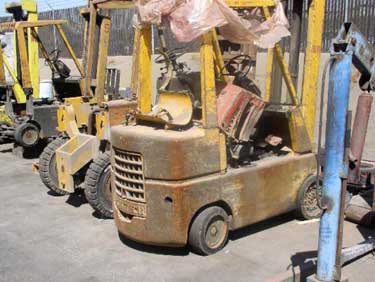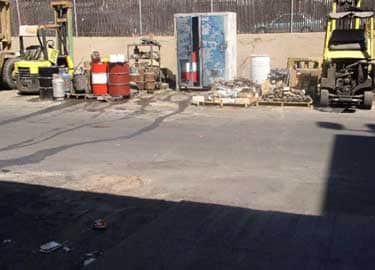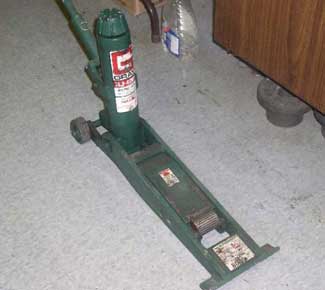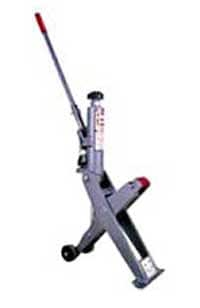A Maintenance Mechanic Died When the Forklift He Was Working on Slipped Off a Jack and Fell on Him
California Case Report: 03CA005
Summary
A 40-year-old Hispanic male maintenance mechanic died when the forklift he was working under slipped off a jack and fell on him. The forklift was not supported with jack stands or cribbing and the front wheels were not chocked. The concrete pavement was wet from an early morning rain and it also had a slight incline up toward the front of the forklift. The company did not offer any specific training to the victim in his occupation. The CA/FACE investigator determined that, in order to prevent future occurrences, employers, as part of their Injury and Illness Prevention Program (IIPP) should:
- Ensure employees use proper jack stands, cribbing and chocking devices when working underneath elevated equipment.
- Ensure shop floors are level and dry before elevating any equipment.
- Ensure employees are properly trained on how to perform their tasks safely.
Introduction
On April 2, 2003, at 9:30 a.m., a 40-year-old Hispanic male maintenance mechanic died when the forklift he was working underneath slipped off a jack and fell on him. The CA/FACE investigator learned of this incident on April 17, 2003, through the Legal Unit of the Division of Occupational Safety and Health (Cal/OSHA). On April 23, 2003, the CA/FACE investigator made contact with the employer of the victim. On August 27, 2003, the CA/FACE investigator traveled to the victim’s place of employment where he interviewed the company’s executive personnel and other employees in the plant. A second investigation took place on September 9, 2003, where pictures of the equipment and scene were taken and other related documents were reviewed.
The employer of the victim was a manufacturer of wire that had been in business for 25 years. The company had 210 employees all working at the facility where the incident took place. The victim had been employed with the company for 11 months. The victim was born in Mexico. It is not known how long he had been in the United States. According to the death certificate, the victim had a 12th grade education. According to the employer, the victim’s primary language was Spanish and he spoke some English.
The employer of the victim had a written safety program. There were not any written safe work procedures for tasks performed in the shop. Safety meetings were held weekly and were documented. The company did not have a written training program. Training was usually accomplished by hands-on training through plant supervisors and co-workers. The immediate supervisor and co-workers who spoke Spanish provided the victim with the company training which was not task specific.
Investigation
The site of the incident was a manufacturing plant of agricultural fencing and wire products. On the day of the incident the victim was assigned to replace the starter on an industrial forklift that weighed approximately 9,000 pounds (Exhibit #1). The forklift was located on a slight incline in the maintenance yard outside the maintenance shop (Exhibit #2). The concrete ground was partially wet due to an early morning rain. The victim used a hydraulic jack rated for 8,000 lbs (Exhibit #3) to raise the rear of the forklift. The forks were lowered and the front wheels were on the ground so the jack did not lift the entire weight of the forklift.
The victim was lying on his back under the left side of the forklift removing the starter. Another employee was working on another forklift about 20 feet from the victim when he heard a noise. He looked in the direction of the noise and saw the forklift on top of the victim and the jack behind the forklift in an elevated position but no longer under the forklift (Exhibit #4). Other employees raised the forklift and placed a metal jack stand and blocks underneath to support its weight. The paramedics were called and the victim was transported to a hospital where he was pronounced dead.
Cause of Death
The cause of death according to the death certificate was blunt head trauma.
Recommendations/Discussion
Recommendation # 1: Ensure employees use proper jack stands, cribbing and chocking devices when working underneath elevated equipment.
Discussion: Once a jack lifts a heavy object, the object must then be supported by either a jack stand or cribbing. Cribbing is the process whereby blocks of wood are placed under the object to support it in an elevated position. Supporting elevated objects with jack stands or cribbing ensures stability of the object especially when work has to be performed under the object. Had the decedent used proper chocking and cribbing to support the load before placing his body underneath it to do work, this incident might have been prevented.
Recommendation #2: Ensure shop floors are level and dry before elevating any equipment.
Discussion: Most jacks are designed to lift a load while they are sitting on a dry, level surface. If the surface is not dry or level, the jack is more likely to slip or tip over. Had the victim used the jack on a level and dry surface, this incident might have been prevented.
Recommendation #3: Ensure employees are properly trained and supervised on how to perform their tasks safely.
Discussion: There are a variety of tools and maneuvers that can be used to safely lift every load, however, the ability to safely use these tools and maneuvers requires specialized training. It is unclear if the victim in this incident had that specialized knowledge since he did not undergo testing of his skills. Had the employer trained his workers and evaluated their skills, or supervised them through observation and correction, this incident might have been prevented.
Exhibits
 |
 |
 |
 |
|
Exhibit #4. A picture of a jack, similar to the one
involved in the incident, in the raised position |
Reference
- California Code of Regulations, Title 8, Sections 3562, 3650
California Fatality Assessment and Control Evaluation (FACE) Project
The California Department of Health Services, in cooperation with the California Public Health Institute, and the National Institute for Occupational Safety and Health (NIOSH), conducts investigations on work-related fatalities. The goal of this program, known as the California Fatality Assessment and Control Evaluation (CA/FACE), is to prevent fatal work injuries in the future. CA/FACE aims to achieve this goal by studying the work environment, the worker, the task the worker was performing, the tools the worker was using, the energy exchange resulting in fatal injury, and the role of management in controlling how these factors interact. NIOSH funded state-based FACE programs include: Alaska, California, Iowa, Kentucky, Massachusetts, Michigan, Minnesota, Nebraska, New Jersey, New York, Oklahoma, Oregon, Washington, West Virginia, and Wisconsin.
To contact California State FACE program personnel regarding State-based FACE reports, please use information listed on the Contact Sheet on the NIOSH FACE website. Please contact In-house FACE program personnel regarding In-house FACE reports and to gain assistance when State-FACE program personnel cannot be reached.
